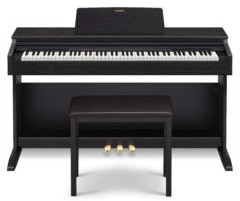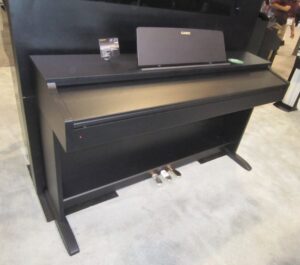🎹 UPDATED REVIEW – Feb 1, 2024 – Casio makes two standard furniture cabinet digital pianos that are identical but have different model numbers. The Casio Celviano AP-265 and AP-270 are the same exact pianos with the exception that the AP-265 is sold primarily by Costco under that model number and the AP-270 is the mainstream version model number you will find on the internet. Otherwise they are the same piano.
line at just $999 (sometimes on sale for less money) internet price for the AP-265 at Costco and $1199 for the AP270 in the mainstream market. The AP-270 is available in 3 different matte cabinet finishes including matte black, matte walnut, and matte white and the AP-265 from Costco is only available in the matte black color.
The factory warranty is longer and better on the AP-270, but there is normally a $200 difference between the AP-265 and AP-270, so it just depends on what you want. Also, it you want or need a brown or white color cabinet then the Costco AP-265 is not available in those cabinet colors.
The Casio AP-265/AP-270 has some advantages over other digital pianos, but there is one area that is lacking, in my opinion, which causes me to downgrade it a bit. This model has a somewhat weak internal speaker system with just 16 watts total power going through 2 speakers pointing downward under the piano. I have played this model many times along with other cabinet digital pianos that only have 16 watts or less and the sound coming out is somewhat anemic and just does not fill up even a medium size room very well.
A BETTER CASIO PIANO SOLUTION –
THE PX-870
However, Casio has a special cabinet model called the PX-870 at $1199 on-line price with 40 watts of internal power going through 4 speakers (2 of those speakers pointing forward) and also has top sound escapement ports so the sound can come up and out of the piano top like a real piano does. The PX-870 also has many more usable digital features as compared to the AP-265/270 to enhance the learning & playing experience. I personally like the Casio PX-870 much better than the AP-265/270 models.
Also, right now we can get you a special unadvertised instant “REBATE” on the PX-870 (black cabinet color) while supplies last. Also there would be no sales tax on the PX-870 and there would be free shipping along with new factory warranty. Please read my detailed review of the PX-870 at the following link: Casio PX-870 Review. We believe this model would be the much better investment in this general price range. The Casio PX-870 will give you more for the money in just about every way based on our experience with it.
 Getting back to the AP-265 and AP-270, you can layer two sounds together for simultaneous play such as strings and grand piano, as well as a split sound function allowing for an instrument sound on the left hand and a different instrument sound on the right hand. Other useful functions and features include transpose, an adjustable metronome for rhythm and timing
Getting back to the AP-265 and AP-270, you can layer two sounds together for simultaneous play such as strings and grand piano, as well as a split sound function allowing for an instrument sound on the left hand and a different instrument sound on the right hand. Other useful functions and features include transpose, an adjustable metronome for rhythm and timing
training, and last but not least a 2-track MIDI recorder for left and right hand piano practice and playback. This 2-part recording system is something other brands of digital pianos do not have and being able to record and playback your left and right hand separately is useful for students.
Key action movement and response is important in any digital piano and this where many brands and models fall short, especially in this lower price range. The AP-265/270 does a good job with the piano weighted key action playing experience along with very nice key movement response. The key action is called “tri-sensor” which simply means that Casio has 3 electronic sensors under each key rather than 2 key sensors as found in the Yamaha YDP-145 as an example, which is competitively priced. The 3rd key sensor normally allows for more accurate key repetition recognition when playing at faster speeds especially when repeating the same notes or doing trills, etc. At this price having a tri-sensor electronics under each key is a good thing and something that adds value to this model.
Piano tonal and volume dynamics is where piano playing “expression” comes in and the AP-265/270 does an adequate job of that, only the low power speaker system in these models does inhibit that somewhat. When you are able to express yourself musically with many different tonal colors, then your musical comes alive and sounds more inspiring. The PX-870 with 256-note polyphony processing chip as opposed to the 192-note polyphony processing chip in the AP265/270 along with its much more advanced internal speaker system does a much better job offering more musical expression as compared to the AP-265/AP270 models.
The Casio AP-265/270 has a unique song playalong feature called “Concert Play” which offers a library of classical music in the piano which were originally recorded as CD wav file audio recordings in a “live” session with actual real orchestra instruments. You can select from any song in the concert library and then you can play along with those songs using the piano for the live sound. When you are playing back any of these orchestral songs you can also slow down the song playback speed so that it is easier to ply along, especially if you not know the song. The songs actually do sound very good and playing along with them is fun and it makes you sound better than you actually are:).
With a total of 22 individual natural instrument sounds, the AP-265/270 furniture cabinet model offers more than twice as many instrument sounds as its nearest competitor. Accessing those sounds is pretty easy as they are listed right above the keys as opposed to other pianos that don’t list them at all and you have to guess at what you are getting. The grand pianos sounds have their own dedicated buttons on the left side control panel for quick easy access.
There are a few other features in this AP-265/270 that I have not covered but they are less important although can be fun and useful depending on the playing skill level you are at and the type of music you will be playing. One of the more requested features these days is to have a USB output to an external device such as an iPad. The AP-265/270 is USB equipped and I use iPad in my teaching studio quite often and some of those iPad apps are really amazing. They can teach kids and adults some important musical fundamentals in an exciting visually pleasing way which helps people to learn to play more easily and many times more quickly while learning important aspects of music theory and live play.
So here’s the bottom line; The Casio AP-265/270 is a lower priced digital piano with some good features in an attractive smaller traditional furniture style cabinet with matching piano bench, sliding key cover, and privacy panel with features that focus on a reasonably good piano playing experience. But as I mentioned earlier, the internal speaker system is disappointing in this price range just like other brands that have a low power speaker system. I would instead recommend to spend a little bit more to get something from Casio, such as the impressive PX-870, that can put out a fuller, richer, and more realistic piano sound.
If you want more info on new digital pianos and LOWER PRICES than internet discounts, please email me at tim@azpianowholesale.com or call direct at 602-571-1864.


























Tim, first of all thanks for maintaining this site. A ton of great information here.
What are your thoughts on the AP 270 versus the new PX 870? As far as I can tell from online sources they are extremely similar, including in price, but with a different emphasis in a few areas. The 270 has a more attractive appearance and the Steinway samples. The 870 has higher polyphony and a more powerful speaker system (I have been leaning toward the 870 for this reason). Do you agree, or is there some other key difference I am missing?
Thanks.
either piano is a good choice. I prefer the Casio AP270 New York Steinway piano sound but if you want a bigger speaker sound and more functions like USB flashdrive, then the PX870 would be the better choice.
What are your thoughts concerning the difference between the AP-270 and the AP-460 models? It seems as though the new Steinway sound might be a deciding factor.
It's not an iPad app, it's also for Android and maybe Windows. This is important, not everyone has/likes iPad.
This is also an important question for me. Can anyone help?
Could you tell us the main difference between casio Ap 460 and ap 270 concerning audio? Is ap 460 grand piano sample as good? Ap 270 is compatible with Casio's Chordana app, whilst Ap 460 isn't. Should that be a deciding factor as well?
please , your opinión about Roland Rp 102 VS Casio ap 270, only concerning about sound and mainly the key weight and its feeling. best regards from Spain
Could you tell me what are the major differences between the Casio AP-260 and AP-270? I understand the AP-270 replaces the 260. But what are the major 'upgrades', and are the upgrades necessary? thank you.